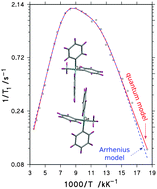A quantum mechanical alternative to the Arrhenius equation in the interpretation of proton spin–lattice relaxation data for the methyl groups in solids†
Abstract
The theory of nuclear spin–lattice relaxation in methyl groups in solids has been a recurring problem in nuclear magnetic resonance (NMR) spectroscopy. The current view is that, except for extreme cases of low torsional barriers where special quantum effects are at stake, the relaxation behaviour of the nuclear spins in methyl groups is controlled by thermally activated classical jumps of the methyl group between its three orientations. The temperature effects on the relaxation rates can be modelled by Arrhenius behaviour of the correlation time of the jump process. The entire variety of relaxation effects in protonated methyl groups have recently been given a consistent quantum mechanical explanation not invoking the jump model regardless of the temperature range. It exploits the damped quantum rotation (DQR) theory originally developed to describe NMR line shape effects for hindered methyl groups. In the DQR model, the incoherent dynamics of the methyl group include two quantum rate (i.e., coherence-damping) processes. For proton relaxation only one of these processes is relevant. In this paper, temperature-dependent proton spin–lattice relaxation data for the methyl groups in polycrystalline methyltriphenyl silane and methyltriphenyl germanium, both deuterated in aromatic positions, are reported and interpreted in terms of the DQR model. A comparison with the conventional approach exploiting the phenomenological Arrhenius equation is made. The present observations provide further indications that incoherent motions of molecular moieties in the condensed phase can retain quantum character over much broader temperature range than is commonly thought.


 Please wait while we load your content...
Please wait while we load your content...